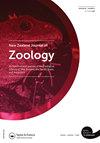Natural history collections: collaborative opportunities and important sources of information about helminth biodiversity in New Zealand
IF 1.1
4区 生物学
Q3 ZOOLOGY
引用次数: 0
Abstract
ABSTRACT Only a small fraction of the Earth’s total biodiversity has been described. This is particularly true of parasitic fauna, due to the paucity of taxonomic expertise, funding, and interest in parasites. It is expected that co-extinctions will become the main cause of species loss with potentially half of the parasite species becoming extinct prior to their discovery. This article addresses this issue and highlights case studies from the Otago Museum (OMNZ) (Dunedin, New Zealand), providing examples of successful collaborations between government organisations, museums, and parasitologists in bridging knowledge gaps in parasite diversity. The case studies presented focus on the parasitic helminths from opportunistic necropsies of stranded marine mammals and deceased birds. Collections from these case studies have doubled the size of the parasite collection at the OM, making this institution the most important repository of parasitic helminths in the country. We encourage such collaborations between museums, governing bodies, indigenous communities, ecologists and parasitologists in enhancing our knowledge of parasite diversity. Furthermore, we urge scientists to deposit both host and parasite tissues from surveys, vouchers, along with their respective metadata so that samples can be adequately stored and curated, thus ensuring that parasite collections become a legacy for future generations of scientists.自然历史收藏:新西兰蠕虫生物多样性的合作机会和重要信息来源
只有一小部分的地球生物多样性被描述。由于缺乏分类学专业知识、资金和对寄生虫的兴趣,寄生动物群尤其如此。预计共同灭绝将成为物种损失的主要原因,可能有一半的寄生虫物种在被发现之前就灭绝了。本文讨论了这一问题,并重点介绍了奥塔哥博物馆(OMNZ)(新西兰达尼丁)的案例研究,提供了政府组织、博物馆和寄生虫学家之间在弥合寄生虫多样性知识差距方面成功合作的例子。案例研究的重点是搁浅海洋哺乳动物和死亡鸟类的机会性尸体中的寄生蠕虫。这些案例研究的收集使OM的寄生虫收集量增加了一倍,使该机构成为该国最重要的寄生虫储存库。我们鼓励博物馆、理事机构、土著社区、生态学家和寄生虫学家之间开展这种合作,以提高我们对寄生虫多样性的认识。此外,我们敦促科学家将调查所得的宿主和寄生虫组织、代金券及其各自的元数据都保存起来,以便充分储存和管理样本,从而确保寄生虫收集成为未来几代科学家的遗产。
本文章由计算机程序翻译,如有差异,请以英文原文为准。
求助全文
约1分钟内获得全文
求助全文
来源期刊
CiteScore
2.80
自引率
0.00%
发文量
20
审稿时长
>12 weeks
期刊介绍:
Aims: The diversity of the fauna of the southern continents and oceans is of worldwide interest to researchers in universities, museums, and other centres. The New Zealand Journal of Zoology plays an important role in disseminating information on field-based, experimental, and theoretical research on the zoology of the region.

 求助内容:
求助内容: 应助结果提醒方式:
应助结果提醒方式:


